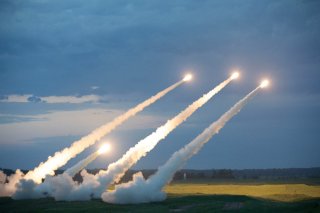Lockheed Martin Set to Upgrade GMLRS Range
The GMRLS munition has been used to devastating effect on the battlefield by Ukrainian forces.
The Guided Multiple Launch Rocket System (GMRLS) is getting a significant upgrade that will extend its range significantly.
In a statement, Lockheed Martin explained that the company “successfully demonstrated its next-generation Extended-Range Guided Multiple Launch Rocket System (ER GMLRS) in a test at White Sands Missile Range, New Mexico. The round was fired Thursday morning from the U.S. Army’s HIMARS® launcher and met all success criteria in a short-range test flight approximately 59 kilometers to the target area.”
The company added that “our next-generation GMLRS provides versatility for commanders, offering a choice of munitions at longer distances with the same reliability and precision the system is known for,” said Jay Price, vice president of Precision Fires at Lockheed Martin Missiles and Fire Control. “This success advances the ER GMLRS closer to production as we complete the final phase of the development program.”
The GMRLS munition has been used to devastating effect on the battlefield by Ukrainian forces. Leveraging the munition’s range and precision capabilities, Ukrainian forces have been able to target important, high-value Russian targets.
Prior to Ukraine’s counteroffensives in the Kharkiv and Kherson oblasts, Russia was able to utilize its huge advantage in artillery firepower. While Ukrainian artillery crews were forced to pick their targets judiciously, Russian artillery pounded Ukrainian positions with impunity, buoyed by their high supply of artillery ammunition.
That changed with the introduction of High Mobility Artillery Rocket Systems (HIMARS) and the M270 Multiple Launch Rocket System (MLRS), wheeled and tracked platforms respectively that fire GMRLS ammunition.
Though Russia’s advantage in artillery guns and ammunition was significant, its Achilles’ heel was how it stored ammunition. Large sprawling ammunition dumps, many of which were out in the open, made for easy targets for Ukrainian HIMARS and M270s. Other high-value targets like command posts were also vulnerable to precision strikes.
Lockheed Martin’s statement also explained that “Testing confirmed flight trajectory, range and accuracy from launch to impact, as well as warhead lethality, HIMARS integration and overall missile performance.”
The new extended-range rocket pod “also underwent Stockpile to Target Sequence (STS) testing prior to launch. This effort simulates cumulative effects the ER GMLRS will meet in the field between factory and launch for the life of the system and demonstrates durability of the missile and launch pod container.”
Though the new Extended Range Guided Multiple Launch Rocket System likely won’t get to Ukrainian forces anytime soon, the rocket’s future looks bright.
Caleb Larson is a multimedia journalist and defense writer with the National Interest. A graduate of UCLA, he also holds a Master of Public Policy and lives in Berlin. He covers the intersection of conflict, security, and technology, focusing on American foreign policy, European security, and German society for both print and radio. Follow him on Twitter @calebmlarson.
Image: DVIDS.

